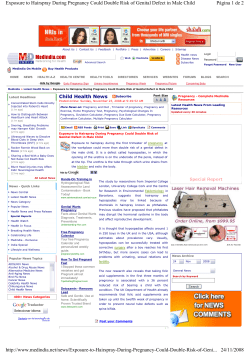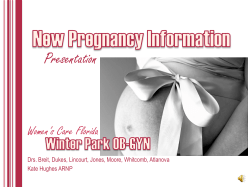
Document 12992
ARIAS-STELLA REACTION-AN EVOLUTIONARY PHENOMENA by c. SYAMALA BHASKARAN,* M.D. and E. SlusEELA DEVl,, * * M.B.B.S. Pregnancy in the human female is ac- in the opposite horn, with pregnancy in companied by numerous rather momen- one horn of a bicornuate uterus. Ariastous changes in the genital tract and the stella (1958) reported 3 instances of miniuterus in particular. Many of these mum atypia in apparently normal early changes have been clearly defined, intrauterine pregnancy. Roach et al others, undoubtedly await discovery. It (1960) have reported a higher incidence was not until 19,54, when Arias-stella em· in term pregnancy than with choriocarphasized the atypical nature of endome- cinoma, syncytial endometritis or hydatid trial epithelium when there is trophobla- mole. The purpose of this paper is to see stic tissue within the body that attention the changes in endometrial glands in cases began to be paid to these changes. He of intrauterine pregnancy and the value studied 182 cases of abortion, 26 cases o£ of atypical endometrial reaction. hydatidiform mole, 14 cases of chorionepithelioma, 4 cases of syncytial endome- Material and Method tritis and 1 case of ectopic pregnancy. This report is based on the histological He pointed out that finding atypical endo- study of endometrial curettings on the metrial changes may be of value in files of the department of Pathology, S. making a presumtive diagnosis of preg- V. Medical College, Tirupati during 197'3 nancy. The changes consist of focal and 1974. There were a total of 1957 endoenlargement of the glands, nuclear metrial curettings out of which 243' were hypertrophy, hyperchromatism, with studied in detail for they showed either folding of nuclear membrane. The cyto- chorionic villi, or decidua with heavy inplasm is vacuolated, abundant, slightly fection or decidua with thick Hood vesacidophilic. There is loss of polarity. sels, fibrinoid necrosis and inflammation Mitosis are frequent. Since Arias-stella's suggestive of intrauterine pregnancy. Out original paper, literature has repeatedly of these, 152 were selected for this study stressed the importance of Arias-stella fo; they showed adequate representation reaction, in the diagnosis of extrauterine of anatomically normal endometrial pregnancy (Tremner, 1956; P'ildes and glands, unaffected directly by the inserWheeler 195,7; Frederiksen 1959) . Moller tion of the placenta. In the rest endome(1959) reported the Arias-stella reaction trial glands were not present and hence the reaction of the endometrial glands *Professor of Pathology. could not be assessed and were eliminat**Tutor in Patholog.y, S. V . Medical College, ed. The clinical diagnosis in 152 cases is Tirupati A. P . set out in Table I and the type of reaction A ccepted for publication OTh 19-8-1975. 861 ARIAS-STELLA REACTION-AN EVOLUTIONARY PHENOMENA of endometrium in Table II. The tissues were fixed in 10% formal saline processed in usual way, sections of 5 to 7 microns were made and stained with haematoxyline and eosin. Sections with Arias-stella reaction were stained with PAS and mucicarmine. decidua with heavy infection. There were 5 cases with Arias-stella reaction, and 25 without Arias-stella reaction. Sixty-eight cases were in group II. These cases showed chorionic villi. Arias-stella reaction was seen in 8 cases. Fifty-four cases were in group III TABLE I Clinical Diagnosis in 152 Cases Showing Endometrial Glands in Intrauterine Pregnancy Clinical diagnosis With AriasStella reaction Without AriasStella reaction Total 6 79 21 2 85 Post abortional bleeding Incomplete abortion Septic abortion Missed abortion Vesicular m9le D.U.B. Sterility Secondary amenorrhea Polymenorrhoea 1 3 8 2 Total TABLE II Reaction of Endometrium Secretory phase Resting or proliferative phase Mixed Arias-stella reaction 11 11 2 5 119 5 23 22 2 3 11 19 2: 3 3 2 6 23 129 1'52 showing thick blood vessels, fibrinoid necrosis, haemorrhage signifying that the pregnancy was intrauterine. Ten of them showed Arias-stella reaction. The endometrial glands were greatly enlarged, the cells showed hypertrophy and hyperplasia, the cytoplasm was Results vacuolated and gave a negative reaction Typical Arias-stella reac:ion was seen to PAS and mucicarmine. ln areas the in 2'3 cases. The cases were grouped into cells were so much proliferated that they 3, as shown in Table III. In group I, were thrown into folds wi:h very little there were 30 cases. Curetting showed ' stroma in between the glands. The TABLE III Incidence of Arias-stella Reaction and the Changes Suggestive of Intrauterine Pregnancy Group I Decidua with infection Group II Chorionic villi. Group III Fibrinoid necrosis of the blood vessels Total With Ariasstella reaction Without Ariasstella reaction 5 8 25 60 68 10 44 54 23 129 152 Total 30 862 JDURNAL OF OBSTETRICS AND GYNAECOLOGY OF INDIA nucleus was also enlarged and hyperchromatic. Sometimes pyknosis was present. Mitosis was frequent. Comment It is well known that under chorionic gonadotrophins, the endometrial glands are stimulated. The nucleus is enlarged and the cytoplasm is foamy. This may be focal or involve several glands (Lloyd & Fienburg 1965). Ferguson (1949) mentioned that the enlarged irregular and hyperchromatic cells may be mis:aken for cancer of the endometrium in cyto. smears. Hilrich & Hipke (1955), Fildes & Wheeler 1957 and Mekles et al (1961) have made similar observations. The incidence of Arias-stella reaction in intrau:erine pregnancy has been quite variable. The reported incidence is as high as 70 % and as low as 0 percent. This variation is explained on the basis whether minor degrees are included in the study. Those who have excluded minor degrees of atypism, like we, find that the incidence is low. Group I cases were clinically diagnosed as intrauterine abortion. E'x amination of the uterine contents showed decidua and endometrium bu t no chorionic villi. Failure to find may be due to (1) chorionic villi and membranes were shed as a cast before curet:age was performed. (2) chorionic villi were never present in the uterus i.e. pregnancy was extrauterine, provided adequate sample of material is submit:ed. In our cases we have excluded extrauterine pregnancy. In this group, the incidence of Arias-stella reaction was 16.7% compared to group II and III where the incidence was 11.8% and 18.9% respectively. It could be seen from this study that when the chorionic tissue is present in the sampling, the in- cidence is lowest compared to Group I and III. It is probable that when chorionic villi are present there is liklihood of prolonged bleeding and shedding of atypical epithelial cells. There are many theories to explain the etiology of the Arias-stella reaction. According to Deelman (1933) the atypical changes can be a :tributed to inflammatory and degenerative process in the endome:.r ium so frequently seen in abortions. Aguerro (1950) explained its histogenesis as a result of pregnancy and inflammation. In the series of Kulj et al (1963) ,there is no evidence of infection associated with Arias-stella reaction. Arias-s :.ella (1955) came to the conclusion that the endometrial changes are the result of hormonal activity of chorionic tissue and confirmed this in experimental rats. Fildes & Wheeler (1957) agreed with this view. The greatly enlarged vacuolated clear cells are due to hydropic degeneration as the cells were negat.ive for PAS and mucicarmine stains. This change, together with fold~ ing of the nuclear membrane and .pyknosis indicate that the Arias-stella reaction is due to involutionary change consequent to the dea :h of foetus (Overbeck 1962). The appearance of mitosis is due to resumption of cyclic ovarian function. When Pathologists sugges ~ the diagnosis of Arias-stella reaction from the study of curettings, the clinician expects the presence of chorionic villi. In the absence of chorionic villi decidua in the curettings, the reaction suggests ectopic gestation (Birch and Collins 1961). Since Abortion Law is liberalised in India, in future it will be possible to study greater number of medically terminated early pregnancies and more light may be thrown on Arias-stella reaction. 863 ARIAS-STELLA REACTION-AN EVOLUTIONARY PHENOMENA Summm·y One hundred and fifty two cases of curettings from intra-uterine abortions were studied for Arias-Stella reaction. Twenty-three showed Arias-stella reaction. The clear cells characteristic of Ariasstella reaction are due to involutionary change consequent to the death of the foetus. They do not contain glycogen. The atypical change in the endometrial glands helps in diagnosis of intrauterine pregnancy, when products have been aborted before admission into the hospital or when products are not accessable to the curette as in extrauterine pregnancy. Acknowledgements We thank Dr. K. B. Krishnamohan, Principal for allowing us to publish this article. We are grateful to the help rendered by Sri R. N arasimhulu Chetty for typing this manuscript and Sri J. S. Sundara Rao for helping us in Photography. 2. 3. 4. 5. Arias-stella, J. : A. M. A. Arch. Path., 58: 112, 1954. Arias-stella, Am. J. Path., 34: 601, 1958. A ugurro, L. : Cirug ginec. Y. U rol. (Madrid) , 1: 278, 1950. Birch, H. W. and Collins, C. G.: Am. J. Obst. & Gynec., 81: 1198, 1961. 6. Deelman, H. T.: cited by reference 5. 7. Ferguson, J. H.: Cancer, 2: 845·, 1949. 8. Frederiksen, T. : Acta. Obst. & Gynec. Scandi ., 38: 262, 1959. 9. Hilrich, N . M. and Hipke, M. M. : Obst. & Gynec., 6: 452, 1955. 10. Kulj, V., Bunarevic, A., Drazancic, A. and Stoilj-Kovic, C.: Am. J. Obst. & Gynec., 87: 499, 1963. 11. Lloyd and Fienberg, R., Am. J . Clin. Path., 43: 428, 1965. 12. Mekles, A., Wolf, S. A. and Pozer, S. N.: Am. J. Obst. & Gynec., 81: 1209, 1961. 13. Moller, N. E. : Acta. Scand., 38: 271, 1959 . 14. Overbeck, L.: cited by reference 10. 15. Fildes, R. B. and Wheeler, J. D.: Am. J. Obst. & Gynec., 73: 79, 1957. 16. Roach, W. R., Guderian, A. M. and Brewer, J . I.: Am. J. Obst. & Gynec., 79: 680, 1960. 17. Truemner, K. M.: A. Path., 61: 149, 1956. Referencel! 1. Arias-stella, J.: A. M. A. Arch. Path., 60: 49, 1955. See Figs. on Art Paper I Obst. & Gynec. M. A. Arch.
© Copyright 2025





















